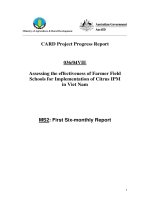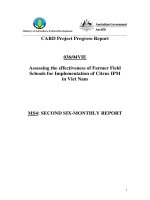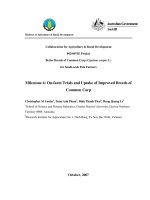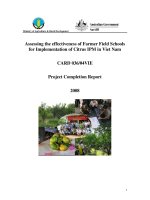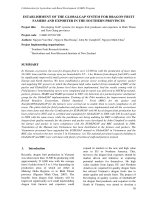Báo cáo nghiên cứu khoa học: "Nguy cơ chấn thương giao thông đường bộ sau khi uống rượu tại Việt Nam" ppt
Bạn đang xem bản rút gọn của tài liệu. Xem và tải ngay bản đầy đủ của tài liệu tại đây (147.96 KB, 12 trang )
437
JOURNAL OF SCIENCE, Hue University, N
0
61, 2010
RISK OF ROAD TRAFFIC INJURY AFTER ALCOHOL CONSUMPTION IN
VIETNAM
Nguyen Minh Tam
1, 2, 4
, Michael P Dunne
2, 4
, Peter S Hill
3
,
Ross McD Young
4
, Pham Van Linh
5
, Jonathon Passmore
6
1
Hue College of Medicine and Pharmacy, Hue University, Vietnam
2
School of Public Health, Queensland University of Technology, Australia
3
School of Population Health, The University of Queensland, Australia
4
Institute of Health and Biomedical Innovation, Queensland University of Technology, Australia
5
Can Tho University of Medicine and Pharmacy, Vietnam
6
World Health Organization - Vietnam Country Office
SUMMARY
Traffic injury is among the leading causes of death in Vietnam. Alcohol use is likely to
be an important contributing factor, but there is little local information. The objectives of this
study were: 1) To measure intoxication among traffic related injured male victims using a
breathalyzer, and 2) To estimate the risk of traffic injury after acute alcohol consumption using
the case-crossover analysis. Methods: Male patients admitted to hospital following traffic
injuries (n=480) were interviewed and their blood alcohol concentration (BAC) were measured.
Risk of traffic injuries after drinking was estimated using case-crossover analysis. Results:
57.5% of male traffic injury patients had a BAC over the legal limit (0.08g/100ml) and 45.6%
were above 0.15g/100ml. The odd-ratios of traffic injuries for patients who drank alcohol within
6 hours prior to injury was 8.5 (95% CI = 5.34 – 13.51). The odds-ratios were 8.8 and 13.4 for
patients who drank 4-5 drinks and ≥6 drinks respectively (p<0.001). Conclusion: These data
indicate that a high proportion of male accident victims have BAC far above the legal limit, and
confirm that risk of injury follows a dose-response function.
Keywords: alcohol, traffic injury, case-crossover, drink-driving
1. Introduction
Road traffic injuries are a major global public health problem but continue to
receive inadequate attention. Alcohol influences both risk and consequence of road
traffic injury but the scale of the problem is not well understood in many countries.
Vietnam has experienced two decades of significant economic development. The
traffic injury pattern has also changed dramatically with road traffic accidents (RTA)
being the leading cause of death and morbidity in Vietnam. A national population-based
438
survey on injuries in eight geographic zones showed a RTA mortality rate of
26.7/100,000 (21,000 deaths in a year, which equates to about 58 deaths daily because
of RTA) and a road traffic injuries (RTI) rate of more than 1,400/100,000 annually
(equates to more than 3,000 people injured per day) .
Whilst data on drinking and driving are very limited in Viet Nam, what is
available indicates a substantial problem. Estimates of alcohol consumption in Viet Nam
indicate an average consumption as high as 64g/day, substantially higher than the
hazardous consumption threshold of 40g/day. There is little consensus in the role that
alcohol plays in traffic crashes amongst available data. Official data suggested that 6%
of all road traffic crashes were associated with alcohol while the National Forensic
Medicine Institute found in 2001, that in a sample of 500 fatal crashes, 34% were
associated with a BAC in excess of national limits.
Drink driving has been prohibited in Vietnam under law since 2001, however
enforcement is limited due to a lack of capacity for detection of intoxication. Under the
new road traffic legislation issued on 1 July 2009, the legally acceptable level of blood-
and breath-alcohol content (BAC) was lowered from the previous BAC threshold of
80mg per 100/ml blood. For motorcyclists, the BAC of 80mg/100ml blood or 40mg/1
litre breath was reduced to 50mg/100ml blood or 0.25mg/1 litre of expired air. For car
drivers, the legal BAC was reduced to zero. The Health Insurance law in Viet Nam
requires all patients presenting at hospital to be tested for alcohol, however this is rarely
implemented underscoring the need for comprehensive epidemiological data.
The current study aims to identify the scale of impact of acute alcohol
consumption on risk of traffic injuries in Vietnam.
2. Methodology
The overall research design is the combination of a cross-sectional survey and a
prospective study of a subset of cases. A pilot has been completed and reported
elsewhere.
This study used case-crossover design in which respondents serving as their own
controls and relative risk was estimated by comparing the exposure frequency during a
window just before outcome onset with exposure frequencies during control times. The
design applies best in studies where the exposure is intermittent, the effect on risk is
immediate and transient, and the outcome is abrupt.
2.1. Sample and data collection
A sample of 480 participants was recruited from Emergency Department (ED) of
Hue Central Hospital (Hue, Vietnam), the biggest general hospital in the Central Region
of Vietnam, with a population catchment of about 3 million people from Thua Thien
Hue Province and neighbouring provinces. The Emergency Department of this hospital
439
is the ‘first point of medical contact’ for patients who have traffic accidents or a medical
emergency.
Data were collected during two periods: October - November 2008 and April -
June 2009. In the data collection periods, we collected data from 5.00 PM to 7.00 AM
the following day of all days (7/7) of the week.
Inclusion criteria were being male aged 18 years and older and being admitted to
the Emergency Department following a recent traffic crash (within 6 hours) with any
type of injury. Those re-attending for treatment of a previous injury were excluded.
Patients who were in police custody, were ventilated, or too severely injured or
unconscious, or too intoxicated to cooperate, were excluded from the analysis.
Patients were asked about the context of drinking prior to injury, regular
drinking patterns, and demographic information, with standardized data collection via
questionnaire. If following consent patients had difficulties in being interviewed but
breathalyzer data were available they were then followed up and interviewed once they
were stable and/or admitted to a ward. Patients not requiring hospital admission all had
data collected before discharge from the Emergency Department.
The Alco Sensor FST breathalyser (Intoximeter Inc., USA) was used to estimate
the breath alcohol concentration. This model of breathalyzer is recognized by the
National Highway Traffic Safety Administration (USA) as an enforcement standard
device and has been used in similar studies.
2.2. Plan of analysis
The study used ‘case-crossover’ analysis in calculating the risk of traffic injuries
after drinking alcohol. Respondents served as their own controls and relative risk was
estimated by comparing the exposure frequency during a window just before outcome
onset with exposure frequencies during control times. The volume of alcohol consumed
was calculated by converting the number and sizes of drinks of beverages to pure
ethanol, in which a standard drink size is 16 ml. Data were recorded as both ‘consumed
alcohol in 6 hours prior to injuries’ (for categorical variable analysis) and BAC level at
the time of breath analysis (for continuous variable analysis). The pair matching
analysis approach was used in which alcohol use during the 6 hours prior to injuries was
compared with alcohol use during the same time period on the same day in the previous
week. Conditional logistic regression was used to calculate matched pair relative risks
and 95 percent confidence intervals.
3. Results
3.1. Characteristics of the sample
During data collection time, there were 1012 male patients admitted to the
Emergency Department with injuries and 66.8% of these were traffic related injuries
440
(n=676). Among the 676 male patients with traffic related injuries, 28 people were
pedestrians, 16 people were driving a car/taxi, 593 people were driving a
motorcycle/bicycle, 7 people were passengers in a car/bus/taxi, and 32 people were
passengers/pillions on a motorcycle/bicycle/rickshaw (cyclo). There were 196 patients
for whom we could not obtain breath analysis and complete interview because they
were either ventilated/resuscitated (9), too severely injured or unconscious (77),
confused (13), too intoxicated to cooperate (16), did not provide consent (61) or because
of other reasons (20) leaving the final sample of size of 480 participants. The
distribution of four groups by socio-demographic variables, alcohol dependent and
injury-related variables are presented in Table 1.
Table 1. Characteristics of the sample
Patients with recent traffic injuries n (%)
p value
Pedestrian
Car driver
Motorcycle
/ bicycle
driver
Passenger
Age (Mean ± SD)
43.33
± 20.551
30.75
± 8.593
30.78
± 11.593
26.71
± 9.987
<0.001
Income (Mean ± SD)
(in multiples of
Vietnamese minimum
annual wage of US $
410)
3.19
± 1.424
3.44
± 1.236
3.30
± 1.335
2.91
± 1.571
0.583
Education level 0.772
Secondary school or
lower
10
(52.6%)
3
(27.3%)
158
(40.6%)
14
(48.2%)
High school
6
(31.6%)
6
(54.5%)
147
(37.5%)
9
(31.0%)
College/University
3
(15.8%)
2
(18.2%)
86
(21.9%)
6
(20.7%)
Marital status 0.286
Single
8
(40.0%)
7
(61.5%)
209
(52.6%)
20
(66.7%)
Married 12 5 189 10
441
(60.0%) (38.5%) (47.4%) (33.3%)
Employment status 0.306
No
4
(19.0%)
1
(7.7%)
67
(17.2%)
9
(29.0%)
Yes
17
(81.0%)
11
(92.3%)
327
(82.8%)
22
(71.0%)
Alcohol dependent
(AUDIT-C)
0.229
No
5
(41.7%)
3
(37.5%)
159
(49.8%)
16
(69.6%)
Yes
7
(58.3%)
5
(62.5%)
160
(50.2%)
7
(30.4%)
The average age was found to be different across groups of victims (pedestrian,
car driver, motorcycle/ bicycle driver, passenger), F (3, 95) = 4.95, p<0.001. The Tukey
multiple comparisons performed at the 0.05 significance level found that the mean age
of pedestrians (M = 43.3, SD = 20.55, N = 21) was significant higher than that for car
drivers (M = 30.8, SD = 8.59, N = 12), motorcycle/ bicycle drivers (M = 30.78, SD =
11.59, N = 414), and passengers (M = 26.71, SD =9.99, N = 31). The mean age for car
drivers, motorcycle/ bicycle drivers, and passengers were not found to be significantly
different from each other. The average income level for car drivers, motorcycle/ bicycle
drivers, and passengers were not found to be significantly different from each other, F (3,
95) = 0.650, p=0.583.
Types of victims (pedestrian, car driver, motorcycle/ bicycle driver, passenger)
were not significantly associated with educational level, χ2 (6, N=450) = 3.288, p=0.772,
marital status, χ2 (3, N=460) = 3.781, p=0.286, employment status, χ2 (3, N=458) =
3.615, p=0.306, and alcohol use disorder status, χ2 (3, N=362) = 4.315, p=0.229.
3.2. Blood alcohol concentration
Table 2 shows the distribution of BAC among 480 patients admitted to the
Emergency Department with recent traffic injuries. Among these patients, 312 (65%)
tested positive for alcohol and 276 (57.5%) had a BAC over Vietnam’s legal limit of 80
mg/100mL. 219 (45.6%) of the injured patients had a BAC of 150 mg/100 mL or
higher.
442
Table 2. Distribution of BAC among traffic related injured male patients
BAC mg/dL Frequency Percent Cumulative %
0 168 35.0 35.0
1-49 22 4.6 39.6
50-79 14 2.9 42.5
80-149 57 11.9 54.4
≥ 150 219 45.6 100.0
Total 480 100.0
Table 3. Blood Alcohol Concentration by individual characteristics
BAC (mg/100ml) n (%)
Total
p
value
a
0 1 – 49 50 – 79
80 – 149
≥ 150
Age <0.05
18-29
90
(33.6%)
9
(3.4%)
13
(4.9%)
31
(11.6%)
(46.6%)
268
(100.0%)
30-39
38
(35.8%)
10
(9.4%)
0
(0.0%)
12
(11.3%)
46
(43.4%)
125106
(100.0%)
>=40
40
(37.7%)
3
(2.8%)
1
(0.9%)
14
(13.2%)
48
(45.3%)
106
(100.0%)
Education level 0.689
Secondary school
or lower
62
(33.2%)
8
(4.3%)
6
(3.2%)
28
(15.0%)
83
(44.4%)
187
(100.0%)
High school
57
(33.9%)
9
(5.4%)
6
(3.6%)
19
(11.3%)
77
(45.8%)
168
(100.0%)
College/
University
39
(40.2%)
3
(3.1%)
2
(2.1%)
7
(7.2%)
46
(47.4%)
97
(100.0%)
Marital Status
0.580
Single
86
(35.2%)
9
(3.7%)
10
(4.1%)
28
(11.5%)
111
(45.5%)
244
(100.0%)
Married 76 12 4 27 99 218
443
(34.9%)
(5.5%)
(1.8%)
(12.4%)
(45.4%)
(100.0%)
Employment status
0.466
No
32
(39.5%)
1
(1.2%)
3
(3.7%)
11
(13.6%)
34
(42.0%)
81
(100.0%)
Yes
129
(34.0%)
20
(5.3%)
11
(2.9%)
44
(11.6%)
175
(46.2%)
379
(100.0%)
Income (in multiples of Vietnameseminimum wage
b
)
0.729
3 wages or less
63
(32.1%)
11
(5.6%)
4
(2.0%)
26
(13.3%)
92
(46.9%)
196
(100.0%)
4 wages and more
58
(32.0%)
6
(3.3%)
6
(3.3%)
21
(11.6%)
90
(49.7%)
181
(100.0%)
Alcohol use
disorders
(AUDIT-C)
<0.00
1
No
87
(47.0%)
10
(5.4%)
10
(5.4%)
18
(9.7%)
60
(32.4%)
185
(100.0%)
Yes
34
(19.0%)
8
(4.5%)
3
(1.7%)
20
(11.2%)
114
(63.7%)
179
(100.0%)
a
Pearson’s Chi-square
b
The minimum wage in Vietnam (2009) is equivalent to an annual income of
US $ 410
Table 3 shows the distribution of BAC by different individual characteristics
among 480 patients admitted to the Emergency Department with recent traffic injuries.
An association between age group and BAC at hospital admission was found, χ
2
(8, N=480) = 15.763, p<0.05. Examination of the cell frequency showed that the
percentage of the group aged 18-29 years that had a BAC of 50 mg/100mL or greater
(63%) was higher than that of the group aged 30-39 (54.8%) and the group aged 40 or
older (59.5%). There was also an association between alcohol use disorder status and
BAC level, χ
2
(4, N=370) = 43.983, p<0.001. People with alcohol use disorders (i.e.
having AUDIT-C score of 5 of more) were more likely to have positive BAC results at
hospital admission. The percentages of patients with alcohol use disorders who had a
BAC of 50 mg/100mL or greater (76.6%) and BAC of 150 mg/100mL or greater
444
(63.7%) were higher than those of patients without alcohol use disorders (47.5 and
32.4%, respectively).
Blood alcohol concentration; however, was not significantly associated with
educational level, χ
2
(8, N=452) = 5.623, p=0.689, marital status, χ
2
(4, N=462) = 2.867,
p=0.580, employment status, χ
2
(4, N=460) = 3.576, p=0.466, and income level, χ
2
(4,
N=377) = 2.038, p=0.729.
3.3. Risk of traffic injuries after alcohol consumption estimated by case-
crossover analysis
Among 480 patients with recent traffic injuries admitted to the Emergency
Department, there were 313 patients (65.2%) reported drinking during the period 6
hours prior to the traffic injuries. Using pair matching strategy for control data in case-
crossover analysis, risk of traffic injuries after alcohol consumption was estimated by
comparing alcohol use during the 6 hours prior to injuries with alcohol use during the
same time period on the same day in the previous week. The results showed that a total
of 186 patients consumed alcohol during the period 6 hours prior to the traffic injuries
but did not drink during the control period and 22 patients drank during the control
period but did not drink in the 6 hours prior to injuries (classified as discordant pairs).
The odds ratios (OR) for sustaining a traffic injury if participants had consumed alcohol
in the 6 hours prior to being injured was 8.5 (95% CI = 5.34 – 13.51, p<0.001). Using
the conditional logistic regression to calculate the odds ratios for matched pairs
(controlling for potential factors of age, education, marital status, employment status,
income level, alcohol use disorders), participants who consumed alcohol in the 6 hours
prior to traffic injuries were 8.9 (95% CI = 5.10 – 15.39) times more likely to sustain a
traffic injury than participants who did not drink.
Table 4. Matched pair analyses of alcohol consumption 6 hours prior to traffic injury and one
week prior to injury by number of drinks consumed among participants
Number of
standard drinks
consumed in 6h
prior to injury
Number of standard drinks
consumed at the same period,
same day in the week before
injury
OR
95% CI
p
0 1 2-3 4-5 ≥6
0 133 5 9 5 5 1
1 4 1 1 1 0 0.80 0.18 – 3.41 1.000
2-3 66 2 11 3 3 7.33 3.54 – 15.75 <0.001
4-5 44 2 7 6 2 8.80 3.35 – 25.19 <0.001
≥ 6 67 1 9 1 26 13.40 5.20 – 37.69 <0.001
445
Table 4 shows the cross-tabulation of the number of drinks consumed in the 6
hours prior to the injury and the number of drinks consumed in the control period. The
OR for each level of consumption is presented. Risk of traffic injuries was correlated
with the number of drinks consumed (p<0.001), except at the level of one drink,
suggesting a dose-response relationship. In particular, the risk increased nearly 9 fold
after consuming 4 or 5 drinks and to more than 13 fold if the respondent reported
consuming 6 drinks or more.
For the validity of results in case-crossover analysis, the agreement between
self-reported alcohol consumption and BAC results was examined. Among 472 patients
completing both BAC and interviews, 6 were negative for self-reported consumption
within 6 hours prior to the injury but had positive BACs, while 9 of the 165 patients
with negative BACs reported drinking during the 6 hours prior to injuries. The Kappa
coefficient was 0.930 (95% CI = 0.894 - 0.965), suggesting a very good agreement
between BAC and self-report. Furthermore, an analysis using Pearson’s correlation
coefficient indicated that there is a strong linear relationship between reported number
of drinks consumed in the 6 hour period prior to traffic injuries and BAC of patients at
admission, r(463) = 0.68, p<0.001 .
4. Discussion
This is the first study in Vietnam to systematically collect the blood alcohol
concentration and estimate the risk of traffic injury after alcohol consumption among
patients admitted to Emergency Department. This is also one of few studies that apply
case-crossover analysis to estimate the risk of road traffic injuries after alcohol use.
Our results showed the rate of patients with BAC above limit of 0.05g/100mL
(60.4%) is much higher compared to results in other countries such as in South Africa
(26 - 31%), in Thailand (44%), or in the study of WHO in 10 countries (18,1%). Our
figures on the proportion of patients who reported drinking prior to injuries (65.2%)
were also higher compared to the estimations in the “World report on road traffic injury
prevention” of the World Health Organization in 2004 in which about 8-29% traffic
related injured drivers (non-fatal) reported drinking before their road traffic crashes.
What is more striking is the high prevalence of injured patients who had a BAC of 150
mg/100 mL or greater in our study (45.6%). This is the intoxication level at which
driving skills are strongly affected and diminished. This prevalence provides a clear
explanation for the high prevalence of traffic injuries in Vietnam and reveals the
magnitude of alcohol as a risk factor to the population of the country.
In the case-crossover analysis, our results indicated that the risk of traffic injury
increased when patients consumed alcohol before driving and there was a more than 13
fold increase when six or more drinks were consumed. Results from our study that
showed there was not a significant increase when patients had a single drink was
446
consistent with previous studies from Mexico. However, in a larger study, Vinson et al.
identified a dose–response relationship between consuming as few as 1–2 alcoholic
drinks and risk of injury (OR = 1.8; 95% CI =1.3–2.6). A recent study, with a large
sample of patients with nonfatal injuries attending 10 emergency departments
worldwide found that the risk of injury increased when patients had a single drink (OR
= 3.3; 95% CI = 1.9–5.7). Taken the data on risk at different levels together, findings in
our study were consistent with results from previous studies in developed countries and
indicate a dose–response relationship between alcohol consumption and the risk of
traffic injury.
A concern in using case-crossover design is the validity of self-reported alcohol
consumption. In our study, there was a very good agreement between BAC and self-
reported alcohol consumption (Kappa coefficient of 0.930; 95% CI = 0.894 - 0.965) and
a significantly strong linear relationship between reported number of drinks consumed
in the prior 6 hours and BAC of patients at admission (Pearson’s correlation coefficient
r(463) = 0.75, p<0.001).
Prevention implications
The high proportion of patients with recent traffic injuries who had a high level
of BAC has implications for prevention strategies. Clearly, education on responsible
drinking and planning to avoid drink-driving is an imperative. In Vietnam, the most
productive intervention would be to encourage people not to drive to drinking events
and when driving to the event is necessary, people should either have a plan for limiting
drinking, or have prearranged alternative travel.
Furthermore, rather than solely targeting driving decisions after drinking, a
reasonable option would be to focus on encouraging alternative transport both to and
from the venue, relieving drinkers of their anxieties around leaving their vehicles
unprotected. Given that public transport is still not widespread and taxis are still not
commonly used due to cost, our suggestion is to promote the local motorbike taxis (“xe
om”) as a potential means of alternative transportation. Motorbike taxis are very popular
in Vietnam for their cheap fares and widespread availability. Nonetheless, warnings
about the safety of impaired passengers when using this means of transport should be
developed.
Policy implications
The evidence for high prevalence of patients with BAC above the legal limit in
this study is consistent with the cautious acknowledgement of the topic as a public
problem in the countries’ policy agenda, as well as the poor traffic law enforcement in
Vietnam. Evidence from other countries has shown that upgrading drink-driving to a
criminal offence may affect the social environment values, the individual’s moral
awareness and influence behavior, particularly if appropriate educational and
447
enforcement efforts take place. Lessons from developed countries show that the
existence of statutes impacts only those least likely to drink and drive, while perceptions
of the likelihood of arrest and individual agreement with the goals of drinking and
driving laws significantly reduce the propensity for almost everyone. Media campaigns
and national coverage of law enforcement are particularly important to increase the
perceived probability of being caught or suffering punishments, which is what actually
influences the credibility of sanctions. The current inconsistency between legal BAC for
drivers of motorcycles, compared to cars, needs addressing. Given the existence of the
law and the recent lowering in the legally acceptable level from the previous BAC
threshold in Vietnam, it would seem critical to strengthen the enforcement along with
mass media campaigns and news coverage in order to decrease the widespread
perception of impunity and thereby, to reduce the level of drink-driving.
5. Conclusion
This is the first study of its kind in Vietnam to examine the risk of traffic injuries
after alcohol consumption. These data indicate that a high proportion of traffic related
male patients have BAC far above the legal limit, and confirm that risk of injury follows
a dose-response function. There was an urgent need for a multi sectoral approach to
curtail drink-driving in Vietnam, especially programs to raise community awareness and
effective legal enforcement.
COMPETING INTERESTS
The authors declare no competing interests. The findings and conclusions in this
report are those of the authors and do not necessarily represent the views of the funding
agency.
Acknowledgements
The authors gratefully acknowledge all participants for making this study
possible. We would like to thank Dr. Tran Thi Doan Trang, Dr. Nguyen Van Dieu, Dr.
Pham Ngoc Quang, Dr. Nguyen Thi Thanh Truc, Dr. Tran Tuan Anh, Dr. Tran Ngoc
Duc, Dr. Nguyen Tuan Long, Dr. Nguyen Tan Cuong, Dr. Vo Van Nhan, Mr. Vo Van
Khoa, Mr. Nguyen Xuan Hung, Mr. Tran Binh Thang, Mr. Nguyen Van Dat for their
contributions in data collection and data entry.
This study was supported by grants from the Atlantic Philanthropies through the
VINE Project and the World Bank through the Road Traffic Injury Research Network.
N.M.T. was also partly funded as a PhD. student in the QUT-Vietnam Public Health
Project supported by the Atlantic Philanthropies.
448
REFERENCES
1. Le VA, Linh LC, PV C. Vietnam Multi-center Injury Survey. Hanoi: Hanoi School of
Public Health; 2003.
2. Hanh VTM. Tình hình lạm dụng rượu bia ở Việt Nam. Alcohol policy: international
experience and the case of Vietnam. Ha noi: Health Strategy and Policy Institute 2006.
3. World Health Organization (Country Office for Vietnam). The Facts - Drinking &
Driving: World Health Organization; 2009.
4. Anh VM. Policies on alcohol in Vietnam. Alcohol Policies: International Experience
and the Case of Vietnam Workshop; 2007; Hanoi; 2007.
5. The National Assembly of the Socialist Republic of Vietnam. Luat Giao thong Duong
bo (Road Traffic Law) (in Vietnamese). In: The National Assembly of the Socialist
Republic of Vietnam, ed.: The National Assembly of the Socialist Republic of Vietnam,
2008.
6. Tam N, Linh P, Hue D, Trang T, Dunne M, Young R, et al. Traffic Injuries After Alcohol
Consumption in Central Vietnam: Perceptions and Risk. The 2
nd
Asia Pacific Injury
Prevention Conference
Hanoi: Ministry of Health, Vietnam 2008.
7. Maclure M. The Case-Crossover Design: A Method for Studying Transient Effects on
the Risk of Acute Events. American Journal of Epidemiology. 1991 January 15,
1991;133(2):144-53.
8. Borges G, Cherpitel C, Orozco R, Bond J, Ye Y, Macdonald S, et al. Multicentre study of
acute alcohol use and non-fatal injuries: data from the WHO collaborative study on
alcohol and injuries. Bulletin of the World Health Organization. 2006; 84:453-60.
9. Borges G, Cherpitel C, Mittleman M. Risk of injury after alcohol consumption: a case-
crossover study in the emergency department. Soc Sci Med. 2004; 58:1191-200.
10. Redelmeier DA, Tibshirani RJ. Association between cellular-telephone calls and motor
vehicle collisions. The New England Journal of Medicine. 1997; 336(7):453.





